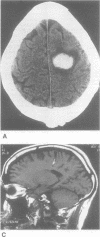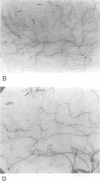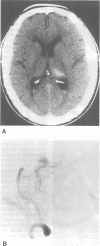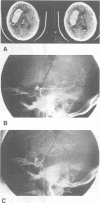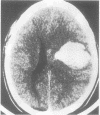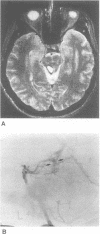Abstract
One hundred and two consecutive patients with cerebral haematoma were prospectively allocated to one of two groups according to their CT on admission. Group 1 patients were thought to have a high probability of an underlying structural lesion and underwent cerebral angiography acutely. If normal, this was repeated at three months. Group 2 patients were thought not to have such a lesion and underwent angiography at three months. Patients older than the mean age of the study population, and hypertensive patients were much less likely to harbour an aneurysm or arteriovenous malformation than younger or normotensive patients (p < 0.01; sensitivity 87.9%, specificity 88.6%). An aneurysm or arteriovenous malformation was the cause of haemorrhage in 12.8% of hypertensive patients, in 30.9% of patients with haematoma involving the basal ganglia, and 18.2% of those with posterior fossa haemorrhage. Features of CT in isolation give a sensitivity of 77.2% and a specificity of 84.2%. Follow up angiography in group 1 showed an arteriovenous malformation in one of seven patients in whom the original study was normal. These results contrast sharply with data from previous retrospective studies. The decision to investigate a patient with cerebral haematoma should be primarily based on the patient's clinical condition, rather than on the site of haemorrhage.
Full text
PDF

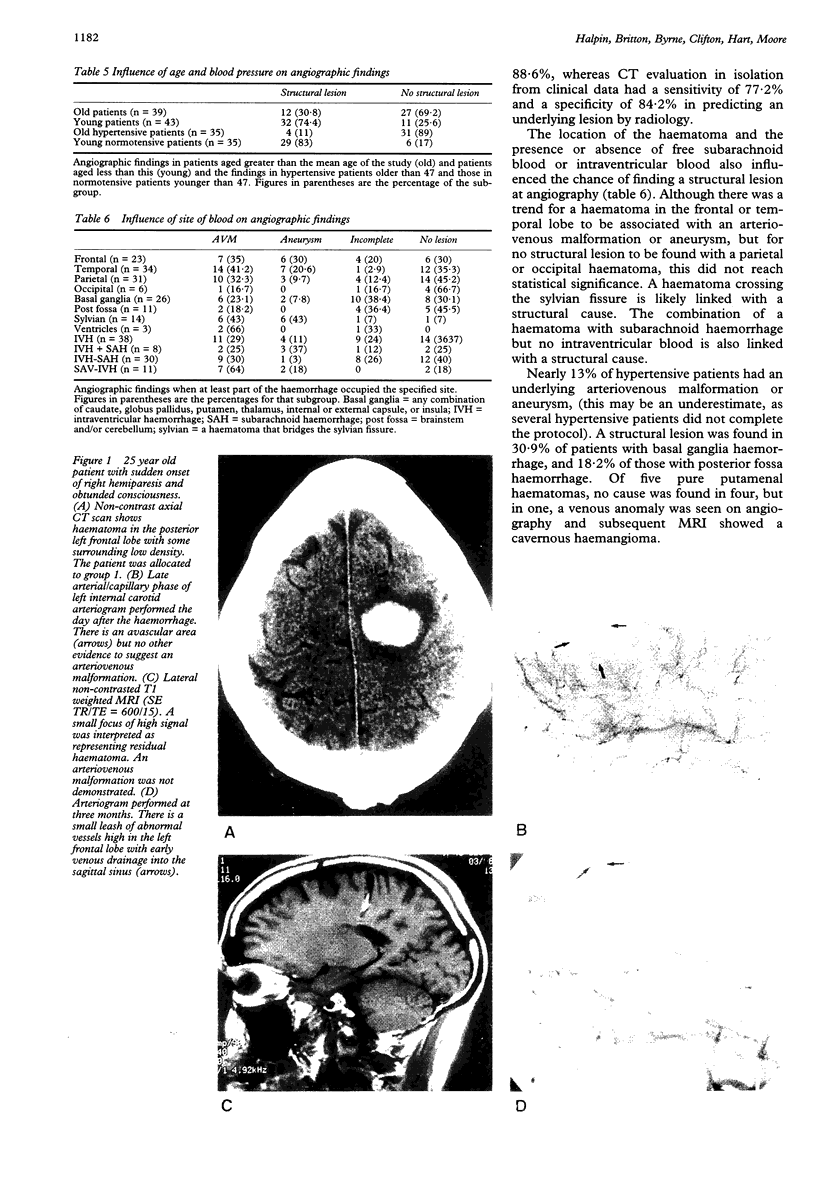
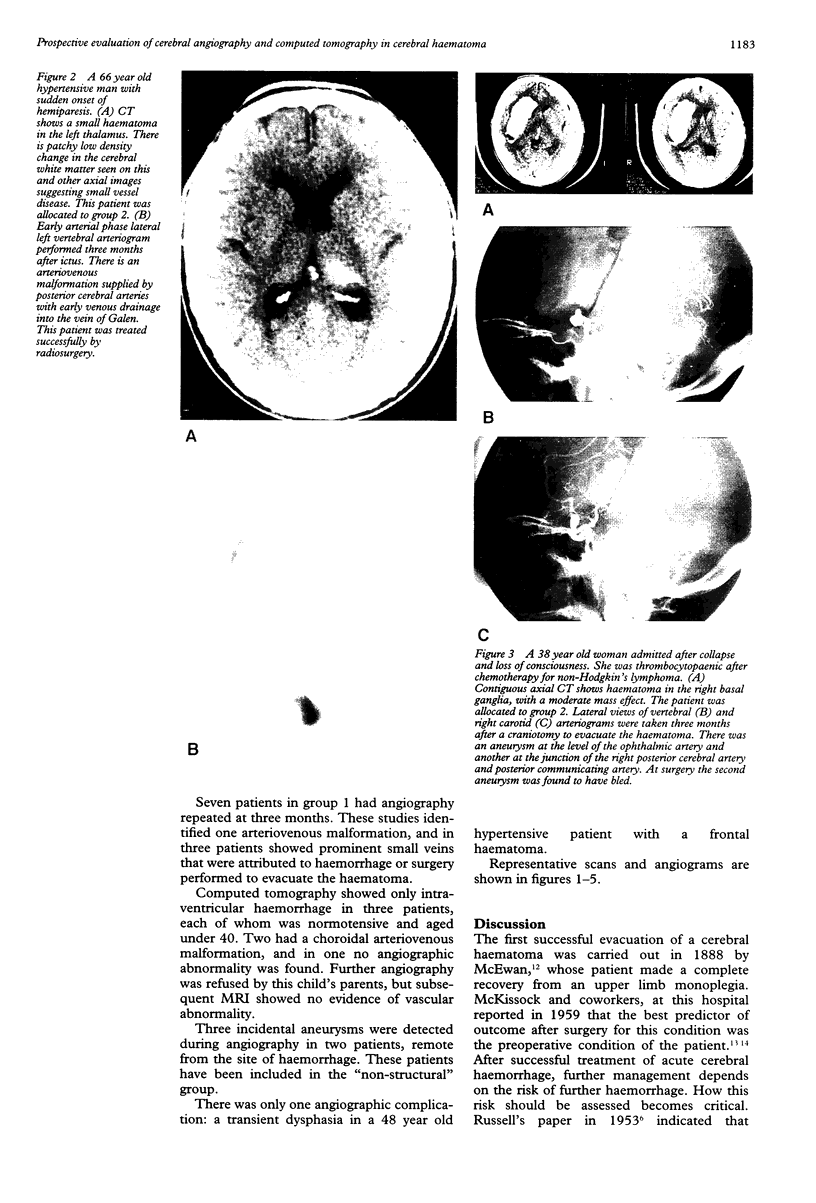
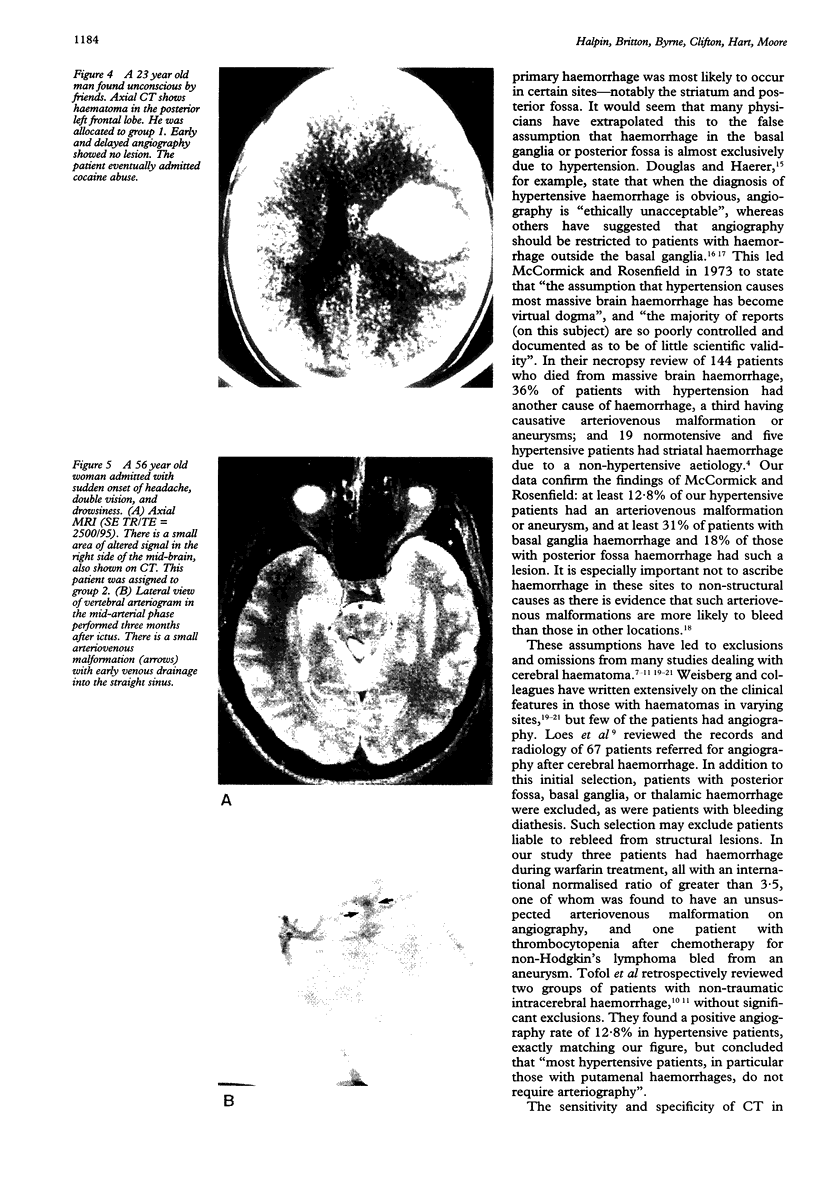
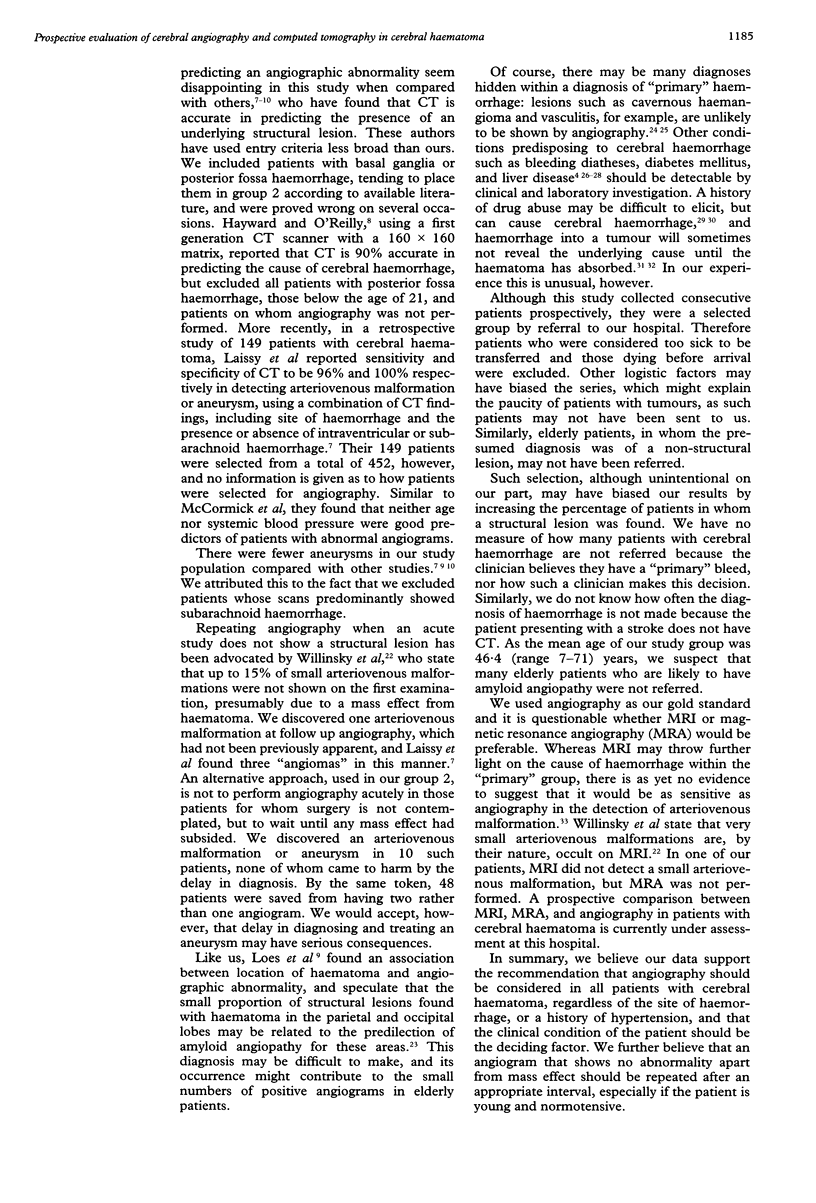

Images in this article
Selected References
These references are in PubMed. This may not be the complete list of references from this article.
- Almaani W. S., Awidi A. S. Spontaneous intracranial bleeding in hemorrhagic diathesis. Surg Neurol. 1982 Feb;17(2):137–140. doi: 10.1016/s0090-3019(82)80042-6. [DOI] [PubMed] [Google Scholar]
- Bessen H. A. Intracranial hemorrhage associated with phencyclidine abuse. JAMA. 1982 Aug 6;248(5):585–586. [PubMed] [Google Scholar]
- Bitoh S., Hasegawa H., Fujiwara M., Sakurai M. Angiographically occult vascular malformations causing intracranial hemorrhage. Surg Neurol. 1982 Jan;17(1):35–42. doi: 10.1016/0090-3019(82)90039-8. [DOI] [PubMed] [Google Scholar]
- Douglas M. A., Haerer A. F. Long-term prognosis of hypertensive intracerebral hemorrhage. Stroke. 1982 Jul-Aug;13(4):488–491. doi: 10.1161/01.str.13.4.488. [DOI] [PubMed] [Google Scholar]
- Gildersleeve N., Jr, Koo A. H., McDonald C. J. Metastic tumor presenting as intracerebral hemorrhage. Report of 6 cases examined by computed tomography. Radiology. 1977 Jul;124(1):109–112. doi: 10.1148/124.1.109. [DOI] [PubMed] [Google Scholar]
- Hayward R. D., O'Reilly G. V. Intracerebral haemorrhage. Accuracy of computerised transverse axial scanning in predicting the underlying aetiology. Lancet. 1976 Jan 3;1(7949):1–4. doi: 10.1016/s0140-6736(76)92904-4. [DOI] [PubMed] [Google Scholar]
- Laissy J. P., Normand G., Monroc M., Duchateau C., Alibert F., Thiebot J. Spontaneous intracerebral hematomas from vascular causes. Predictive value of CT compared with angiography. Neuroradiology. 1991;33(4):291–295. doi: 10.1007/BF00587808. [DOI] [PubMed] [Google Scholar]
- Loes D. J., Smoker W. R., Biller J., Cornell S. H. Nontraumatic lobar intracerebral hemorrhage: CT/angiographic correlation. AJNR Am J Neuroradiol. 1987 Nov-Dec;8(6):1027–1030. [PMC free article] [PubMed] [Google Scholar]
- McCormick W. F., Rosenfield D. B. Massive brain hemorrhage: a review of 144 cases and an examination of their causes. Stroke. 1973 Nov-Dec;4(6):946–954. doi: 10.1161/01.str.4.6.946. [DOI] [PubMed] [Google Scholar]
- Ojemann R. G., Heros R. C. Spontaneous brain hemorrhage. Stroke. 1983 Jul-Aug;14(4):468–475. doi: 10.1161/01.str.14.4.468. [DOI] [PubMed] [Google Scholar]
- Ojemann R. G., Mohr J. P. HYPERTENSIVE BRAIN HEMORRHAGE. Clin Neurosurg. 1976;23:220–244. doi: 10.1093/neurosurgery/23.cn_suppl_1.220. [DOI] [PubMed] [Google Scholar]
- Papo I., Janny P., Caruselli G., Colnet G., Luongo A. Intracranial pressure time course in primary intracerebral hemorrhage. Neurosurgery. 1979 Jun;4(6):504–511. doi: 10.1227/00006123-197906000-00002. [DOI] [PubMed] [Google Scholar]
- RUSSELL D. S. Spontaneous intracranial haemorrhage. Proc R Soc Med. 1954 Aug;47(8):689–693. doi: 10.1177/003591575404700817. [DOI] [PMC free article] [PubMed] [Google Scholar]
- Ruscalleda J., Peiró A. Prognostic factors in intraparenchymatous hematoma with ventricular hemorrhage. Neuroradiology. 1986;28(1):34–37. doi: 10.1007/BF00341763. [DOI] [PubMed] [Google Scholar]
- Scott M. Spontaneous intracerebral hematoma caused by cerebral neoplasms. Report of eight verified cases. J Neurosurg. 1975 Mar;42(3):338–342. doi: 10.3171/jns.1975.42.3.0338. [DOI] [PubMed] [Google Scholar]
- Toffol G. J., Biller J., Adams H. P., Jr Nontraumatic intracerebral hemorrhage in young adults. Arch Neurol. 1987 May;44(5):483–485. doi: 10.1001/archneur.1987.00520170013014. [DOI] [PubMed] [Google Scholar]
- Toffol G. J., Biller J., Adams H. P., Jr, Smoker W. R. The predicted value of arteriography in nontraumatic intracerebral hemorrhage. Stroke. 1986 Sep-Oct;17(5):881–883. doi: 10.1161/01.str.17.5.881. [DOI] [PubMed] [Google Scholar]
- Tsementzis S. A. Surgical management of intracerebral hematomas. Neurosurgery. 1985 Apr;16(4):562–572. [PubMed] [Google Scholar]
- Vinters H. V., Gilbert J. J. Cerebral amyloid angiopathy: incidence and complications in the aging brain. II. The distribution of amyloid vascular changes. Stroke. 1983 Nov-Dec;14(6):924–928. doi: 10.1161/01.str.14.6.924. [DOI] [PubMed] [Google Scholar]
- Waltimo O., Kaste M., Aho K., Kotila M. Outcome of stroke in the Espoo--Kauniainen area, Finland. Ann Clin Res. 1980 Dec;12(6):326–330. [PubMed] [Google Scholar]
- Weisberg L. A. Computerized tomography in intracranial hemorrhage. Arch Neurol. 1979 Jul;36(7):422–426. doi: 10.1001/archneur.1979.00500430052007. [DOI] [PubMed] [Google Scholar]
- Weisberg L. A. Subcortical lobar intracerebral haemorrhage: clinical-computed tomographic correlations. J Neurol Neurosurg Psychiatry. 1985 Nov;48(11):1078–1084. doi: 10.1136/jnnp.48.11.1078. [DOI] [PMC free article] [PubMed] [Google Scholar]
- Willinsky R. A., Fitzgerald M., TerBrugge K., Montanera W., Wallace M. Delayed angiography in the investigation of intracerebral hematomas caused by small arteriovenous malformations. Neuroradiology. 1993;35(4):307–311. doi: 10.1007/BF00602622. [DOI] [PubMed] [Google Scholar]
- Willinsky R., Lasjaunias P., Comoy J., Pruvost P. Cerebral micro arteriovenous malformations (mAVMs). Review of 13 cases. Acta Neurochir (Wien) 1988;91(1-2):37–41. doi: 10.1007/BF01400525. [DOI] [PubMed] [Google Scholar]
- Willinsky R., Lasjaunias P., Terbrugge K., Pruvost P. Brain arteriovenous malformations: analysis of the angio-architecture in relationship to hemorrhage (based on 152 patients explored and/or treated at the hopital de Bicêtre between 1981 and 1986). J Neuroradiol. 1988;15(3):225–237. [PubMed] [Google Scholar]
- Yu Y. J., Cooper D. R., Wellenstein D. E., Block B. Cerebral angiitis and intracerebral hemorrhage associated with methamphetamine abuse. Case report. J Neurosurg. 1983 Jan;58(1):109–111. doi: 10.3171/jns.1983.58.1.0109. [DOI] [PubMed] [Google Scholar]



